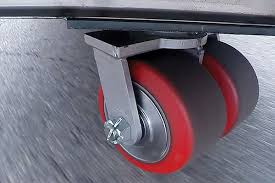The Unsung Heroes of Industry: Casters and Their Essential Role in Manufacturing and Logistics
Casters, often unnoticed yet essential, are vital in the industrial landscape, enabling the seamless operation of numerous processes. These functional devices might not garner attention, but their contribution to manufacturing, warehousing, and healthcare is substantial. From facilitating smooth transitions on factory floors to ensuring logistical precision, large casters lay the foundation for efficient movement. They significantly boost productivity and safety by allowing for the effortless transport of heavy equipment and goods. Casters are often taken for granted despite their crucial role when evaluating overall industrial efficiency. The choice of caster type, size, and material significantly impacts operational success, optimizing operations, cost savings, and equipment longevity. Recent innovations in caster technology have transformed them into smart devices, enhancing efficiency.
The Different Types of Casters and Their Uses
Casters are available in various forms, each designed for specific functions and environments. Swivel casters allow for multidirectional movement, making them perfect for navigating tight spaces where precision is key. In contrast, rigid casters offer straightforward, stable motion, ideal for tasks requiring directional stability, such as moving heavy loads in a straight line. Lockable casters provide flexibility in movement combined with the security of stationary tasks, effectively preventing equipment from slipping or rolling away. Knowing each caster type’s specific applications and benefits is essential for maximizing their utility and ensuring optimal performance.
Choosing the Right Caster for Your Needs
Selecting the right caster involves carefully considering various factors, each crucial to ensuring the final choice meets your operational needs. The process begins by evaluating the average weight the caster will need to support, as this determines the load capacity required. Additionally, considering the type of surfaces and environmental conditions the caster will encounter, such as moisture, chemicals, or extreme temperatures, is necessary to determine the appropriate material and design. By following a comprehensive checklist addressing these details, businesses can avoid costly mistakes and ensure that their casters provide reliable and efficient service, ultimately contributing to a more streamlined operation.
Innovations in Caster Technology
Recent advancements in caster technology are transforming these devices into high-performance components that significantly enhance workplace safety and productivity. Innovative features such as self-braking mechanisms, which activate to prevent unwanted movement, reduce the risk of accidents and injuries, thus promoting a safer working environment. Enhanced ergonomic designs improve the ease of use and reduce strain on workers, increasing efficiency and job satisfaction. Additionally, materials that absorb shock and reduce vibration protect the equipment being transported and preserve the integrity of the surfaces they traverse. These innovations represent a shift towards more intelligent, more adaptive casters that cater to the evolving needs of the industry.
Maintaining and Extending the Life of Casters
Regular maintenance is essential to maximize the lifespan of casters and ensure their continued reliability. This includes scheduled inspections to identify wear and tear signs, lubricating moving parts to prevent rust and friction, and timely replacement of worn-out components. Ensuring casters are not overloaded and used on appropriate surfaces can prevent unnecessary strain and damage. By implementing these maintenance practices, businesses can avoid costly replacements and operational disruptions, preserving productivity and minimizing downtime.
The Economic Impact of Using Quality Casters
Investing in high-quality casters may require a higher upfront cost, but the long-term benefits far outweigh the initial expenditure. Quality casters enhance productivity by minimizing equipment downtime, thus ensuring uninterrupted workflow. They also reduce maintenance expenses, as durable materials and designs require less frequent repairs and replacements. Analyzing future impacts reveals that these savings, combined with the improved efficiency and reduced risk of equipment damage, make a compelling case for their inclusion in strategic resource planning. Ultimately, quality casters can lead to significant economic gains, providing businesses with a clear advantage in a competitive marketplace.
Real-World Applications and Success Stories
Numerous companies have shared success stories highlighting the transformative impact of integrating high-quality casters into their operations. For example, a logistics company significantly improved its warehouse handling capabilities, cutting down the time required to move supplies by over 20%, thanks to robust casters custom-suited to their specific operational requirements. Similarly, a healthcare facility enhances patient safety and staff efficiency by adopting ergonomic, easy-to-maneuver casters for medical equipment. These real-world applications demonstrate how investing in the right casters can increase productivity and a competitive market edge.
Future Trends in Caster Development
Promising developments in caster development are anticipated in the future to satisfy the changing needs of contemporary industries. The integration of IoT technology is a noteworthy trend that minimizes unplanned downtimes and enables predictive maintenance by providing real-time caster performance monitoring. Businesses can preserve operational continuity and efficiency thanks to this creative approach to asset management. A significant trend in caster manufacture is using sustainable materials, which lessen environmental effects while preserving excellent performance. Casters will continue to be crucial in determining how industrial operations develop in the future, making sure they stay flexible, responsive, and environmentally responsible as these trends gain traction.

